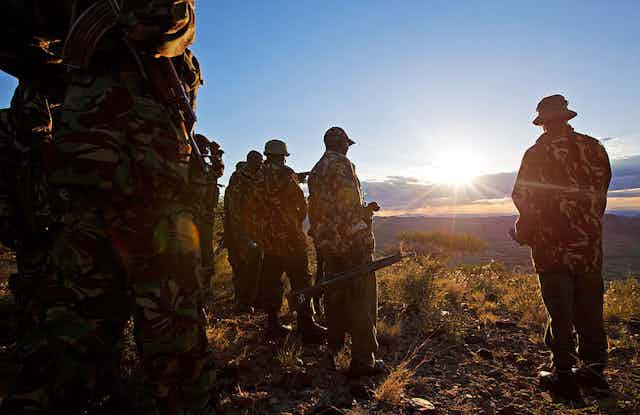Conflict and insecurity are prevalent in northern Kenya. In recent weeks, cases of bandit attacks in the region have left villages terrorised and led to several deaths. In October 2022, the government launched a multi-agency security operation aimed at curbing further attacks.
Northern Kenya is characterised by a wide expanse of wilderness, harsh climate and low levels of development. The region borders Ethiopia, Somalia, South Sudan and Uganda.
Instances of conflict and insecurity range from attacks by armed bandits and cattle rustlers to community disputes over resources and terrorism. The region covers about 60% of Kenya’s geographical territory. It is occupied by about 18% of the country’s population.
Pastoralism is the main economic activity. Others include irrigated agriculture, small-scale businesses and tourism-related activities. The region is largely isolated from the rest of the country due to poor infrastructure, including roads.
According to National Police Service crime statistics, between January and December 2021, 73% of the country’s stock theft raids occurred in the northern region. Over the same period, 58% of the illegal arms recovered and surrendered to the government were from northern Kenya.
The government – past and present – has run numerous operations to address the violence in the region, which threatens Kenya’s overall security. But it hasn’t worked.
As a professor of political science who researches conflict, I’ve had the region on my radar for some time. In my assessment, violent conflict in northern Kenya is driven by five key factors that must be addressed by both state and non-state agencies.
1. Regional inequality, exclusion and marginalisation
Inequality between regions in Kenya is caused by decades of political, economic and social exclusion and marginalisation. This is a product of colonial and post-colonial state policies that have led to historical injustices and human rights abuses.
Colonial authorities neglected Kenya’s arid and semi-arid regions by prioritising development in the country’s natural resource-endowed highlands. Successive post-independence governments continued to pursue policies that further marginalised the north. This has damaged trust in state institutions and produced communal grievances that hinder inter-group unity.
Post-colonial state security actors have also disproportionately targeted Somali inhabitants in counterinsurgency and counterterrorism measures in the north. The main terrorist threat comes from the Somalia-based Al-Shabaab group.
In 2010, Kenya decentralised power by allocating funds and responsibilities to its 47 county governments. This was aimed at improving service delivery at the regional level. While this has begun to address northern Kenya’s marginalisation, repressive security operations continue to fan inter-group conflicts and radicalisation to violent extremism. The use of force in these operations disproportionately targets marginalised communities.
2. Resource and environmental factors
Disputes over land, access to pasture, and conflicts between herders and farmers continue to drive violence in Kenya’s north.
Competition for scarce resources, such as pasture, water and now oil, has worsened these disputes.
Kenya announced it had discovered oil in Turkana County in 2012. Oil exploration has introduced new tensions between resident Turkana and Pokot ethnic groups, and within the Turkana community. Some members of the Turkana believe that the community has not substantially benefited from the resource exploitation.
A rise in crimes like highway robberies is attributed to these communal conflicts.
3. Political power struggles
Power struggles between politicians have fuelled conflict along ethnic lines in the north.
Elective political posts are perceived to provide access to economic resources. Devolving power to the counties along with political alliances have helped to decentralise political power and the provision of essential services. However, they have intensified local-level political competition. Politicians incite inter-clan rivalry, escalating tensions and undermining the benefits of devolution.
4. Cultural practices
Cultural practices contribute to violence in northern Kenya. These practices largely manifest through cattle rustling.
Cattle rustling and stock theft are partly driven by economic motives. These include a desire to restock herds depleted by a lack of pasture and water during droughts. Cattle rustling also provides an opportunity to make money from trading in stolen animals.
Cultural practices such as marriage settlements also drive cattle rustling.
This disrupts community livelihoods, and the use of automatic weapons in raids has led to a high number of deaths. State-led disarmament efforts have had little effect.
5. Proliferation of small arms and weapons
The proliferation of weapons in the region is, to a large extent, caused by cross-border activities.
Kenya’s borders with Ethiopia, Somalia, South Sudan and Uganda are porous and have contributed to the increase in small arms, illicit trade in cattle, terrorism and other forms of organised crime.
Efforts by the state to manage domestic and cross-border conflicts through repressive disarmament operations have instead increased tensions between borderland communities and the state.
Read more: South Sudan should disarm civilians – the evidence shows this improves security
The way forward
State security agencies have the constitutional mandate to use force to deter and disrupt acts of violence that are a threat to national security. However, their methods are often formal and based on power.
Non-state actors, on the other hand, adopt informal methods that are widely accepted in local communities. They are based on mutual trust and are therefore seen as more legitimate.
Both state and non-state actors have the resources, technical expertise and experience to address the drivers of conflict in Kenya’s northern region. A flexible approach that involves various actors can broadly contribute to good governance, and reduce conflict and security incidences.
Read more: Training local leaders in mediation can reduce violence: positive results in Nigeria
This approach would entail all parties working together to promote dialogue, education and peacemaking. It also would include ensuring inclusive political representation in local-level traditional conflict management approaches.

